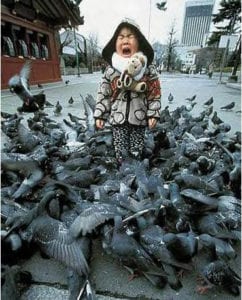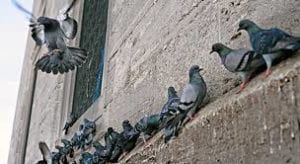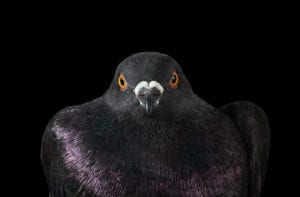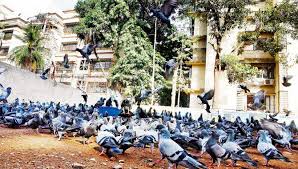
by Pigeon Patrol | Feb 5, 2020 | Animal Deterrent Products, Bird Deterrent Products, Bird Netting, Bird Spike, Bird Spikes, Pigeon Control, Pigeon Droppings, Pigeon Patrol's Services, Pigeon Spikes, UltraSonic Bird Control

Pigeons terrifying child
Bird that scares people, Ornithophobia is the medical term for bird phobias, but many people without a bona fide phobia still fear the creatures. Alfred Hitchcock’s horror film, “The Birds that scares people,” even played into people’s penchant to duck for cover when a bird is around. And of all the bird species, pigeons seem to get the worst rap of them all. Often called “rats of the sky,” pigeons used to be well respected for their homing abilities and were employed during wars to send messages back and forth between troops and base camp. According to HSUS, Hindu and Islamic nations still love these birds, but the tone is different in the United States, where many consider them flying rodents that spread disease and leave bird droppings everywhere they land.
An average pigeon is about 13 inches (32 centimeters) in length and weighs a little less than a pound. This bird is quite adept at living in heavily populated cities and makes its nests in support structures, on building ledges and under bridges. While pigeons and other birds have been known to dive bomb into a person’s head on occasion, you should really only be fearful of flying poop. Pigeon droppings do carry fungi that put humans at risk of contracting diseases, such as histoplasmosis. However, the odds of getting a disease from a pigeon are very low, and the few known cases in which that happened involved pigeon pet owners, not random city slickers.
Source
At Pigeon Patrol, we manufacture and offer a variety of bird deterrents, ranging from Ultra-flex Bird Spikes with UV protection, Bird Netting, 4-S Gel and the best Ultrasonic and audible sound devices on the market today.
Contact us at 1- 877– 4– NO-BIRD, (604) 585-9279 or visit our website at www.pigeonpatrol.ca
Bird Gone, Pigeon Gone, Seagull Gone, Pigeon issue, pigeon spikes, 1-877-4NO-BIRD, 4-S Gel, Bird Control, Pigeon Control, bird repellent, Bird Spikes, sonic bird repellent, stainless steel bird spikes, bird spikes Vancouver, Ultra Sonic Bird Control, Bird Netting, Plastic Bird Spikes, Canada bird spike deterrents, Pigeon Pests, B Gone Pigeon, Pigeon Patrol, pest controller, pest control operator, pest control technician, Pigeon Control Products, humane pigeon spikes, pigeon deterrents, pigeon traps, Pigeon repellents, Sound & Laser Deterrents, wildlife control, raccoon, skunk, squirrel deterrent, De-Fence Spikes, Dragons Den, Canada bird spikes, Canada pigeon, pigeon control, pigeon patrol, pigeon. Kill pigeons, crow, starling

by Pigeon Patrol | Feb 5, 2020 | 4-S Gel Bird repellent, Animal Deterrent Products, Bird Deterrent Products, Bird Netting, Bird Spikes, Pigeon Droppings, Pigeon Patrol's Services, Pigeon Spikes, Pigeons in the News, UltraSonic Bird Control
With a warm spell of weather predicted, staff from Pigeon Patrol Pest Control are gearing up for more calls to deal with the bird they call the ‘flying rat’. 
Pigeons take advantage of the warmer weather to sit on outside ledges and pipework while their fouling fall to the floor below, creating a dangerously slippery surface.
Pigeon Patrol: “With pigeons now breeding four or five times a year, compared to two or three times 20 years ago, their numbers are increasing dramatically. The problem is exacerbated by people feeding them and attracting them into town squares where they are fouling on pavements and buildings.
“Pigeons are the most unhygienic and messy birds and actually carry more diseases than rats. They nest on their poo and attract mites. Nearly all pigeons carry the bird mite – a tiny insect that feeds off the bird, but will also makes humans itch and scratch. Pigeon fouling and nest materials also provide a home for many other insects such as clothes moths, carpet beetle and meal worm beetles.
Most of the pest controllers’ work against pigeons tends to be proofing of buildings and light wells, using a variety of techniques including installing nets, sprung wire systems and bird spike repellents.
Pigeon Patrol explained: “If a slipped tile goes unnoticed on a roof, or the louvers slip on a church bell tower, a pair of pigeons can get in and, in a matter of months, there can be hundreds of pigeons living in the loft space. The floor will soon be covered with fouling up to a foot deep.res further ‘natural-style’ habitats for these descendants of the Rock Dove – ll then have health and safety implications for engineers who come to service the equipment.
“Pigeon poo, when it is wet, is not too much of a danger apart from being slippery and the acidity will, of course, burn car paintwork. But when it is dry, as it often is in a loft space, or below sheltered machinery, then the airborne bacteria can become a real problem – affecting anybody that may be susceptible to asthma and other breathing difficulties.”
When pest controllers are called in, wearing special safety gear, they have to remove the birds, the nests and all loose fouling. The places they have to get to are often difficult to access, very restricted, very hot loft spaces that are about four-feet high – which is one of the reasons they dislike pigeons so much.
Pigeon Patrol Products and Services offers a specialist bird control service for facilities and property management companies in London, Sussex. Surrey and Kent, from the initial survey and specification through to the final proofing solution. As registered waste carriers, Pigeon Patrol can carry out full scale removal of bird fouling, as well as contaminated goods and furniture, from infested properties. As well as the feral pigeon, seagulls are becoming a greater problem for property owners and Pigeon Patrol can also offer advice and solutions for these pests as well.
Some facts about pigeons:
• A pigeon aged between 1 and 30 days is called a squab
• A pigeon’s white feathers have no color pigment
• Pigeons can see in color, but can also see ultra-violet light – a part of the light spectrum that humans cannot see
• Most birds take a sip of water and throw their heads back so it trickles down their throat – pigeons suck up water like straws
• In the 16th century, pigeon poo was a highly valued commodity as it was a source of salt petre or Potassium nitrate – a main ingredient of gunpowder! In France, it was also used to fertilise vineyards
• In India, the pigeon post mail service stopped in 2004
• Cher Ami and GI Joe were two famous war hero pigeons…both saved the lives of many soldiers by carrying important messages across enemy lines
• Young pigeons remain in their nests for up to two months…which is why it is only pest controllers who often get to see them!
• Peregrine Falcons are a natural predator of the pigeon…they can dive at up to 200 miles per hour. A pigeon can dive at about 70 miles an hour.
For more info
At Pigeon Patrol, we manufacture and offer a variety of bird deterrents, ranging from Ultra-flex Bird Spikes with UV protection, Bird Netting, 4-S Gel and the best Ultrasonic and audible sound devices on the market today.
Contact us at 1- 877– 4– NO-BIRD, (604) 585-9279 or visit our website at www.pigeonpatrol.ca
Bird Gone, Pigeon Gone, Seagull Gone, Pigeon issue, pigeon spikes, 1-877-4NO-BIRD, 4-S Gel, Bird Control, Pigeon Control, bird repellent, Bird Spikes, sonic bird repellent, stainless steel bird spikes, bird spikes Vancouver, Ultra Sonic Bird Control, Bird Netting, Plastic Bird Spikes, Canada bird spike deterrents, Pigeon Pests, B Gone Pigeon, Pigeon Patrol, pest controller, pest control operator, pest control technician, Pigeon Control Products, humane pigeon spikes, pigeon deterrents, pigeon traps, Pigeon repellents, Sound & Laser Deterrents, wildlife control, raccoon, skunk, squirrel deterrent, De-Fence Spikes, Dragons Den, Canada bird spikes, Canada pigeon, pigeon control, pigeon patrol, pigeon. Kill pigeons, crow, starling

by Pigeon Patrol | Feb 5, 2020 | Animal Deterrent Products, Bird Deterrent Products, Bird Netting, Bird Spikes, Pigeon Control, Pigeon Droppings, Pigeon Patrol's Services, Pigeon Spikes, UltraSonic Bird Control
If you shoo a pigeon, that bird is likely to remember you and know to stay out of your way the next time you cross paths, according to a new study. Researchers found that wild, untrained pigeons can recognize individual people’s faces and are not fooled by a change of clothes.

Previous research in this arena had only focused on the perception abilities of pigeons that were trained in a lab environment, but the new study was conducted on untrained feral pigeons. At a park in Paris, two researchers of similar build and skin color, but wearing different-colored lab coats, fed a group of pigeons.
One researcher ignored the pigeons after feeding them, allowing them to eat the food, while the other was hostile and chased them away. This was followed by a second session when neither researcher chased away the pigeons. [Pretty Bird: Images of a Clever Parrot]
The experiment was repeated several times, with the pigeons continuously recognizing the individuals faces and avoiding the researcher who had first chased them away even when the participant no longer did so. Swapping lab coats during the experiments did not confuse the pigeons, and they continued to stay away from the researcher who had been initially hostile.
“It is very likely that the pigeons recognize the researchers by their faces, since the individuals were both female and of a similar age, build and skin color,” study researcher Dalila Bovet of the University of Paris Ouest Nanterre La Défense said in a statement.
“Interestingly, the pigeons, without training, spontaneously used the most relevant characteristics of the individuals (probably facial traits), instead of the lab coats that covered 90 percent of the body,” Bovet added.
The researchers noted that the birds appear to be able to differentiate between humans and are aware that clothing color is not a good way to tell humans apart. They theorize that this recognition ability may have come about over the long period of association with humans, from early domestication to many years of living in cities.
Previous research supports the findings, as the memory and recognition skills of certain bird species have been demonstrated by other studies. In May 2011, Seoul National University researcher Won Young Lee noticed that when he returned to an area where he had previously installed cameras into the nests of magpies, the birds recognized his face and began dive-bombing him.
A 2009 study showed that jackdaws, which are the smaller cousins of crows and ravens, can interpret human eye cues and even follow human gestures such as pointing. University of Oxford researchers noted that hand-raised jackdaws could find food when a familiar person’s eyes looked back and forth from the food to the bird. The birds also responded when the person pointed to the food’s location. However, the jackdaws took longer to approach food when an unfamiliar person was watching.
“I think they can generalize to human eyes somehow, and interpret human eyes as eyes,” said Auguste Bayern, a cognitive biologist at the University of Oxford and lead author of the 2009 study.
source
At Pigeon Patrol, we manufacture and offer a variety of bird deterrents, ranging from Ultra-flex Bird Spikes with UV protection, Bird Netting, 4-S Gel and the best Ultrasonic and audible sound devices on the market today.
Contact us at 1- 877– 4– NO-BIRD, (604) 585-9279 or visit our website at www.pigeonpatrol.ca
Bird Gone, Pigeon Gone, Seagull Gone, Pigeon issue, pigeon spikes, 1-877-4NO-BIRD, 4-S Gel, Bird Control, Pigeon Control, bird repellent, Bird Spikes, sonic bird repellent, stainless steel bird spikes, bird spikes Vancouver, Ultra Sonic Bird Control, Bird Netting, Plastic Bird Spikes, Canada bird spike deterrents, Pigeon Pests, B Gone Pigeon, Pigeon Patrol, pest controller, pest control operator, pest control technician, Pigeon Control Products, humane pigeon spikes, pigeon deterrents, pigeon traps, Pigeon repellents, Sound & Laser Deterrents, wildlife control, raccoon, skunk, squirrel deterrent, De-Fence Spikes, Dragons Den, Canada bird spikes, Canada pigeon, pigeon control, pigeon patrol, pigeon. Kill pigeons, crow, starling

by Pigeon Patrol | Feb 5, 2020 | 4-S Gel Bird repellent, Bird Deterrent Products, Bird Spike, Pigeon Patrol's Services, Pigeon Spikes, Pigeons in the News, UltraSonic Bird Control
LONDON (Reuters Life!) – Scientists studying pigeons have found that the often reviled urban bids that dominate city squares around the world carry two harmful disease-causing bugs that make them a public health hazard. 
The findings of the study by a team of researchers in Spain show that although these bacteria can be harmful to humans, they appear to cause no harm to the birds themselves.
As a result, pigeons — often dubbed “rats with wings” by those who suspect them of spreading disease — can act as living “reservoirs” for some harmful bugs, the scientists said.
“Animals that live in close contact with humans can be dangerous reservoirs of human pathogens,” wrote Fernando Esperon from the Animal Health Research Center in Madrid, who led the study. “These birds may therefore pose a public health risk to the human population.”
Inhabitants of cities from London to Venice to New York to San Francisco tend to have a love-hate relationship with the millions of urban pigeons that dominate city plazas, street-side cafes and monuments. Their droppings plaster Trafalgar square in London, St Mark’s square in Venice, and Times Square in New York, where they peck endlessly at crumbs or leftover food.
For this study, which was published in the BioMed Central journal Acta Veterinaria Scandinavica, Esperon and colleagues analyzed 118 pigeons captured using gun-propelled nets from urban areas of Madrid to find out the prevalence of certain bacteria known to cause disease in humans.
They found a bug called Chlamydophila psittaci in 52.6 percent of the pigeons captured, and another bug called Campylobacter jejuni in 69.1 percent.
Psittacosis infection in humans often starts with flu-like symptoms and can develop into life-threatening pneumonia. And according to Esperon, bugs from the campylobacter species are one of main causes of acute diarrhea across the world.
“In fact, in many countries such as England and Wales, Canada, Australia and New Zealand, Campylobacter jejuni infection causes more cases of acute diarrhea than infection by salmonella species,” he wrote.
Like other bugs, salmonella bacteria can cause fever, diarrhea, nausea and vomiting in those infected with it.
The scientists said that although the birds themselves did not seem to get sick from the bacteria, they could potentially pass them on the humans.
“These data should be taken into account for pigeon population management,” they wrote.
Source
At Pigeon Patrol, we manufacture and offer a variety of bird deterrents, ranging from Ultra-flex Bird Spikes with UV protection, Bird Netting, 4-S Gel and the best Ultrasonic and audible sound devices on the market today.
Contact us at 1- 877– 4– NO-BIRD, (604) 585-9279 or visit our website at www.pigeonpatrol.ca
Bird Gone, Pigeon Gone, Seagull Gone, Pigeon issue, pigeon spikes, 1-877-4NO-BIRD, 4-S Gel, Bird Control, Pigeon Control, bird repellent, Bird Spikes, sonic bird repellent, stainless steel bird spikes, bird spikes Vancouver, Ultra Sonic Bird Control, Bird Netting, Plastic Bird Spikes, Canada bird spike deterrents, Pigeon Pests, B Gone Pigeon, Pigeon Patrol, pest controller, pest control operator, pest control technician, Pigeon Control Products, humane pigeon spikes, pigeon deterrents, pigeon traps, Pigeon repellents, Sound & Laser Deterrents, wildlife control, raccoon, skunk, squirrel deterrent, De-Fence Spikes, Dragons Den, Canada bird spikes, Canada pigeon, pigeon control, pigeon patrol, pigeon. Kill pigeons, crow, starling

by Pigeon Patrol | Feb 5, 2020 | Animal Deterrent Products, Bird Deterrent Products, Bird Netting, Pigeon Control, Pigeon Droppings, Pigeon Patrol's Services, Pigeon Spikes, Pigeons in the News, UltraSonic Bird Control
Are Urban Vermin, the Most Disease-Ridden Animals?
Infections carried by animals are a rising threat—and those who work with livestock may have the most to fear
In many cities, pigeons—to take one urban animal—are reviled as flying vermin. They whitewash ledges and pick at filthy crumbs in the gutter. And, yes, these, dubbed by some as “rats with wings,” do carry diseases that humans can catch. But so do innumerable wild creatures outside city limits, the animals we eat—even our beloved pets.
Pigeons are guilty of transmitting fungal and bacterial diseases, primarily via their droppings, which pose the greatest risk to those with weakened immune systems. But cast against the recent spread of infectious zoonotic diseases—such as H5N1 bird flu, severe acute respiratory syndrome (SARS) and human immunodeficiency virus (HIV)—experts question the degree of concern over the disease-bearing potential of the birds that have colonized cities the world over.
In principle, any animal can carry a disease that humans could catch. But Marm Kilpatrick, an ecologist at the Consortium for Conservation Medicine in New York City, which studies human-induced environmental change, species health and biodiversity, wrote in an e-mail: “In reality, the vast majority [about 99.999 percent] of pathogens that are carried by animals won’t infect people.”
Even so, zoonotic diseases represent a growing proportion of emerging infectious diseases; two British studies calculated that about 75 percent of emerging infectious diseases are zoonotic. (By comparison, about 60 percent of all human pathogens can infect animals.)
Real rats (the ground-hugging kind) aren’t innocent by any means: Research links them with the reemergence of bubonic plague and typhus. But bats (of whom “winged rats” is more apropos) may be giving the unpopular rodents a run for their infamous reputation. Long associated with rabies, bats gained new notoriety in the 1990s after outbreaks of the Hendra and Nipah viruses killed both humans and livestock in Australia and Southeast Asia, respectively. A few years later SARS terrified the world by taking flight on commercial airlines. The virus left a trail leading back to the live animal markets in China, first to civet cats and subsequently to bats, the latter vector now believed to be the true starting point for the virus.
And, despite increasing urbanization throughout the world, people and wildlife are sharing more infections. In the Hendra and Nipah outbreaks, habitat fragmentation and increased contact between wild bats and domestic animals have been implicated. Bushmeat, particularly that of our close cousins the chimpanzee, has caused Ebola outbreaks in Africa.
In the U.S., prairie dog owners caught monkey pox from their pets. And the reforestation of Northeastern states over the past century has allowed deer populations to boom, spreading Lyme disease.
By comparison, pigeons’ potential for spreading bird flu seems rather minimal. So far most of nearly 220 human deaths caused by the pathogenic H5N1 strain of bird flu have been traced to contact with poultry. And the strain has yet to arrive in North America. If a similar one were to emerge here, the result could be disastrous for industrial farm workers before anyone else, according to Gregory Gray, director of the University of Iowa’s Center for Emerging Diseases.
“Exposure to domestic birds has changed markedly,” he says. In the nation’s confined animal feeding operations (CAFOs)—the industrial operations that have replaced family farms with at minimum 9,000-chicken or 750–large pig facilities—agricultural workers spend much more time in close contact with animals than a farmer would have 50 years ago.
These are potentially the mixing pots for the next flu pandemic, Gray argues. When an outbreak occurs undetected in a facility, viruses can mutate as they cycle through large flocks or herds. Gray and his colleagues have shown farmers, veterinarians and meat processors all had high swine influenza infection rates, and avian veterinarians carry more bird flu.
In 1983 a low-grade bird flu virus, perhaps left by ducks, spread into chicken warehouses in Pennsylvania. There, it mutated from a minor infection to become what Robert Webster, the virologist at the scene, called “Ebola for chickens.”
This outbreak took two years and the destruction of 17 million birds to control. Webster links some of its spread to New York City’s live bird markets, where chickens are packed into cages in close quarters with ducks and geese, natural carriers of bird flu.
Webster believes these markets pose a greater risk than CAFOs in the developed world where so-called “biosecurity” procedures to keep diseases out have been tightened since the emergence of H5N1. “Live bird markets are the breeding place for all pandemic strains in my opinion,” he says, and, despite attempts to purge it, avian influenza continues to show up in American live bird markets.
But for those whose daily animal interaction doesn’t extend beyond shooing squirrels or feeding the dog, the prospect of zoonotic disease shouldn’t keep them awake at night. “Most people should be more afraid to walk into a doctor’s office during flu season,” says Pennsylvania State University avian pathologist Patty Dunn.
As for pigeons: research has shown that even those infected with bird flu actually transmit very little. And they carry so little West Nile virus in their bloodstreams that they are unlikely to infect mosquitoes who could then infect humans, Kilpatrick says, making the birds more likely to slow an epidemic than spread one.
Source
At Pigeon Patrol, we manufacture and offer a variety of bird deterrents, ranging from Ultra-flex Bird Spikes with UV protection, Bird Netting, 4-S Gel and the best Ultrasonic and audible sound devices on the market today.
Contact us at 1- 877– 4– NO-BIRD, (604) 585-9279 or visit our website at www.pigeonpatrol.ca
Bird Gone, Pigeon Gone, Seagull Gone, Pigeon issue, pigeon spikes, 1-877-4NO-BIRD, 4-S Gel, Bird Control, Pigeon Control, bird repellent, Bird Spikes, sonic bird repellent, stainless steel bird spikes, bird spikes Vancouver, Ultra Sonic Bird Control, Bird Netting, Plastic Bird Spikes, Canada bird spike deterrents, Pigeon Pests, B Gone Pigeon, Pigeon Patrol, pest controller, pest control operator, pest control technician, Pigeon Control Products, humane pigeon spikes, pigeon deterrents, pigeon traps, Pigeon repellents, Sound & Laser Deterrents, wildlife control, raccoon, skunk, squirrel deterrent, De-Fence Spikes, Dragons Den, Canada bird spikes, Canada pigeon, pigeon control, pigeon patrol, pigeon. Kill pigeons, crow, starling

by Pigeon Patrol | Feb 5, 2020 | Animal Deterrent Products, Bird Spike, Pigeon Control, Pigeon Droppings, Pigeon Patrol's Services, Pigeon Spikes
A rare virus that can be contracted by humans has killed a large number of Victorian pigeons after being detected in Australia for the first time.

A type of avian paramyxovirus has resulted in the deaths of a number of hobby pigeon flocks.
Australian chief veterinary officer Dr Mark Schipp said the birds had died suddenly in large numbers.
The birds had sometimes appeared tired or shown neurological signs such as circling or head flicking before death.
He said human infection was extremely rare and usually occurred after contact with an infected bird.
“The rare virus causes only mild, short-term conjunctivitis or influenza-like symptoms [in humans],’’ Dr Schipp said.
“State veterinary authorities have been asked to review the health of their pigeon and poultry flocks.
“At this stage, there are no reports of this virus causing disease in wild birds, but we have asked the Australian Wildlife Health Network to be alert to this possibility.’’
Dr Schipp said the national Consultative Committee on Emergency Animal Disease had met twice to discuss the outbreak, which is being managed by Victorian chief veterinary officer Dr Hugh Millar and industry and veterinary authorities.
Dr Schipp said the consultative committee has agreed to investigating pigeon and other bird holdings where disease is suspected and to quarantine affected properties.
Anyone concerned about their pigeons or birds should contact an experienced poultry veterinarian, their local department of agriculture, or the Emergency Animal Disease Watch hotline on 1800 675 888.
Source
At Pigeon Patrol, we manufacture and offer a variety of bird deterrents, ranging from Ultra-flex Bird Spikes with UV protection, Bird Netting, 4-S Gel and the best Ultrasonic and audible sound devices on the market today.
Contact us at 1- 877– 4– NO-BIRD, (604) 585-9279 or visit our website at www.pigeonpatrol.ca
Bird Gone, Pigeon Gone, Seagull Gone, Pigeon issue, pigeon spikes, 1-877-4NO-BIRD, 4-S Gel, Bird Control, Pigeon Control, bird repellent, Bird Spikes, sonic bird repellent, stainless steel bird spikes, bird spikes Vancouver, Ultra Sonic Bird Control, Bird Netting, Plastic Bird Spikes, Canada bird spike deterrents, Pigeon Pests, B Gone Pigeon, Pigeon Patrol, pest controller, pest control operator, pest control technician, Pigeon Control Products, humane pigeon spikes, pigeon deterrents, pigeon traps, Pigeon repellents, Sound & Laser Deterrents, wildlife control, raccoon, skunk, squirrel deterrent, De-Fence Spikes, Dragons Den, Canada bird spikes, Canada pigeon, pigeon control, pigeon patrol, pigeon. Kill pigeons, crow, starling







